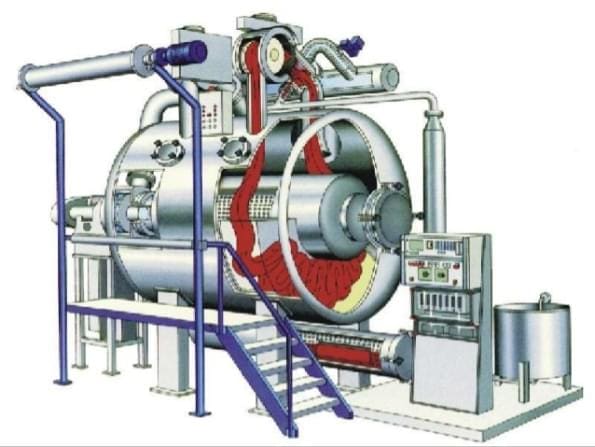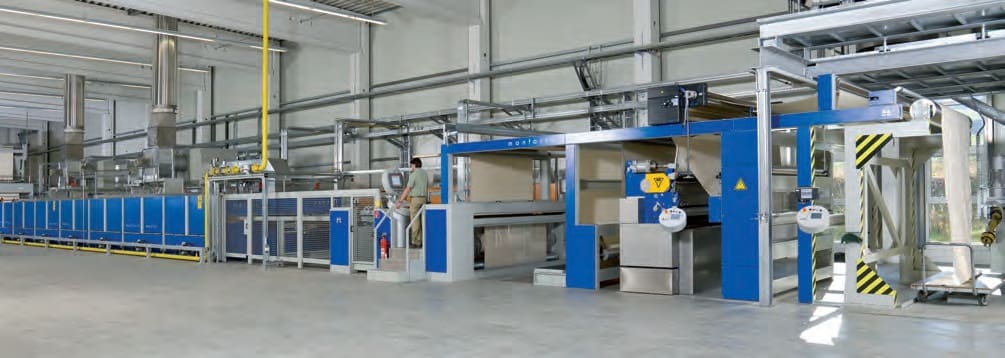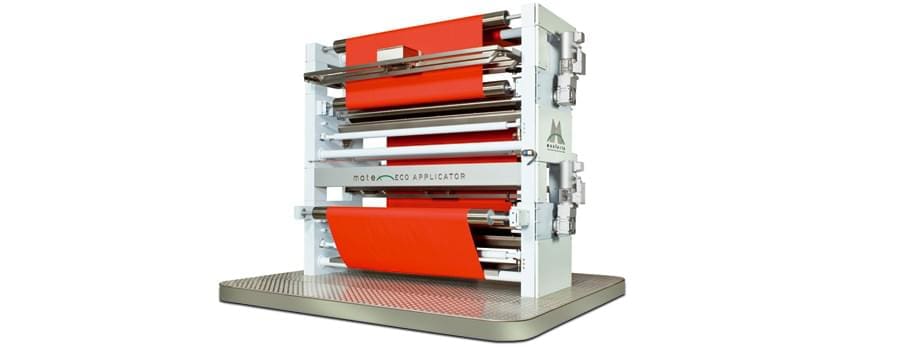Sustainable Technologies in Textile Machinery
Introduction:
Sustainable technology refers to the technology which caters the needs of the present without compromising the ability of future generation to meet their own needs. It enables more valuable use of the natural resources & greatly reduced ecological impact among other technological benefits. Though sustainable technology deals with energy efficiency, reduction in pollution, use of renewable sources, it should also be economically sustainable!
Sustainable Technology
=
Economic Growth
+
Environmental Protection
The consumption of natural resources has been increased exponentially in past decades in rapidly industrializing countries & it is relatively recently that we have started recognizing the unpleasant consequences of the carefree attitude towards the natural environment. Textile industry is among the most essential consumer goods industry in the world as it is one the basic needs of the man. Today, the world of fashion is glamorous & very stylish;
however its impact on ecology worsening day by day. Textile industry is condemned of being one of the most polluting industries in the world. Not only production but consumption of textiles also produces waste. At every stage of the textile production, vast amount of energy, clean water & chemicals are being used to process the textiles & apparels. In turn these processes generate air, water & soil pollution through untreated effluent generation & waste generation which place heavy burden on environment. More than 2000 types of dyes, chemicals & other auxiliaries are being used in Textile Industry. The World Bank estimates that almost 20% of global industrial water pollution comes from the treatment and dyeing of textiles. Some of the toxic chemicals cannot be filtered or removed. Dyeing, washing and after-treatment of textiles requires large amounts of fresh water. Cotton production accounts for 2.6% of annual global water usage. A single T-shirt made from conventional cotton requires 2700 liters of water and a third of a pound of chemicals to produce. Millions of gallons of wastewater discharged by mills each year contain chemicals such as formaldehyde (HCHO), ammonia, chlorine, heavy metals such as lead and mercury & other pigments. These chemicals cause both environmental damage and human disease. Effluents released from mills are often at high temperatures and pH, which exacerbate the problem. Conventional cotton is highly dependent on pesticides, herbicides and fertilizers to grow. In many regions, insects limit cotton production and some of these pests become resistant to pesticides. Not surprisingly, cotton pesticides and herbicides account for 10% of all agricultural chemicals and 25% of all pesticides used worldwide each year. Untreated dyes cause chemical and biological changes in our aquatic system, which threaten species of fish and aquatic plants. The presence of these compounds also makes practical water use unhealthy or dangerous. The enormous amount of water required by textile production competes with the growing daily water requirements of the half billion people that live in drought-prone regions of the world. By 2025, the number of inhabitants of drought-prone areas is projected to increase to almost one-third of the world’s population. If global consumption of fresh water continues to double every 20 years, the polluted waters resulting from textile production will pose a greater threat to human lives.
Today, the growing awareness of environmental issues makes customers to select eco-friendly products over conventional products. While the end-consumers of textiles were earlier concerned with only the finished product, there has been an increasing drive to better understand the input materials, the relevant production processes and their implications on the environment, be it air, water or soil. Ignorance and indifference to these will no longer remain an option for the textile supply chain, so it has become imperative that Textile Industry should address such issues within our supply chain & adopt better and cleaner technologies. Moving to greater degree of sustainability in our industrial processes and systems requires that we achieve better balance between social, economic & environmental aspect of the textile production. With the increasing awareness environmental issues posed by Textile industry, many of technology providers are working towards the improvement of technology to reduce the environmental damage created by the Textile Industry & reduce the consumption of energy, water & chemicals. Some of the innovative environmentally efficient technology solution at reduced production cost.
The Textile Wet processing industry is now in the spotlight due to the recent Detox campaign by Greenpeace and will have to align with the goal of zero discharge of hazardous chemicals by 2020 that is being pursued by several leading International Brands & Retailers.
Some of Sustainable Technologies in Textile Machineries:
Following are the technologies are currently being used worldwide as an answer to sustainability:
- Exhaust Piece Dyeing:
A combination of advantages of long tube machine design with aerodynamic fabric transportation principle has been developed by THEN with their new development the THENAIRFLOW®
THENAIRFLOW® Machine
LOTUS machine which is the world’s first long tube machine to operate using to the original aerodynamic principle. The objective of the development was to create a system that would be especially suitable for the wet processing of delicate, easily creased, cellulose and synthetic fibre knits and wovens with a high percentage of elastane fibre, which are used in the lingerie, sport, leisure and swimwear segments. Resource benefits focus on ultra-low liquor ratio 1:2 to 1:5 with associated reduction in water demand, effluent volume and loading from reduced salt consumption when reactive dyeing and a reduced energy requirement. FONG’S have further refined their JUMBOFLOW machine with Advanced Intelligent Rinsing (AIR) with the option of a conductivity measurement to detect when the concentration of electrolyte has reduced after reactive dye processing to a concentration where the rinsing is transferred to the soaping stage, thereby optimising water consumption.
THIES have further developed their ecoMaster machine incorporating Multi Contact Dyeing from the double liquor : fabric interchange design to permit reduced dyeing times and low liquor ratios from 1:3 for synthetics to 1: 4.5 for cotton fabrics, and an auto control of the rinsing procedure using RINSEtronic software to further reduce process times and water consumption.
- Cold Pad Batch Dyeing
For vertical knitted fabric operations there is a renewed interest in reactive dye application by cold pad batch application due to the lower consumption of water and reduced effluent loading, with a claimed reduction in variable costs of between 15 and 30%. The resultant fabric has a much cleaner stitch definition due to no surface abrasion, and to produce a similar g/sq.m fabric as exhaust dyeing, an increase in stitch density should be considered at the knitting stage if the Cold Pad Batch application route is in ended.
Developments in machine design are mostly for open width processing using sophisticated auto-centre and edge uncurling devices but also include dosing pumps, low-liquor troughs and configurations to allow dye application in the nip as well as in the low-liquor trough. Also on modern pad rollers the pressure can be adjusted across the full width to allow uniform liquor pick-up to eliminate side-centre-side variation.
Integrated heating and cooling systems have also been developed to ensure constant temperature in the pad trough regardless of the time of day/season and thus improve the reliability of the process re liquor stability/hatching time
- Continuous Dyeing
Econtrol® Process: The Econtrol® process utilises the innovation of the Thermex Hot Flue from MONFORTS. The innovation exploits the thermodynamics of water evaporation from cellulose to provide the optimum temperature and moisture conditions within the Hot Flue dryer ideal for the efficient fixation of the specially selected reactive dyes. MONFORTS have in conjunction with DyStar further developed the successful Econtrol® process and at ITMA Munich in 2007 launched the new Econtrol T-CA process for the coloration of polyester/cellulose blends. This development combines the humidity control for reactive dyes with a Thermosol unit for application of new Dianix® T-CA disperse dyes and a new auxiliary package which obviates the need for an intermediate reduction clear process. The savings in chemicals, water, and energy are significant.
Monfort’s Econtrol® process
Along with newest machine technology, the right dye selection also places an important role & hence to maximise the synergy between innovative machinery design and application process to deliver productivity, cost efficiency, and environmental benefits, it is critical to optimise dye selection.
Energy Efficiency:
Energy efficiency is an integral part of sustainability. For many years textile finishing has operated with chemical and thermal processes which, by present-day standards, can have a severe impact on the environment. The energy costs are high, and the use of chemicals absolutely essential. But with innovative ranges and advanced auxiliaries, Monforts has succeeded in optimising these processes. The savings benefits that have been achieved in recent years are in some cases, quite considerable.
- Monforts Eco Applicator
An excellent example highlighting how the Blue Competence concept can influence the R&D activities is the Matex Eco Applicator; a unit which
significantly reduces the initial moisture content before the drying process. The challenge of sustainability is to save natural resources without compromising production quality of the final products. The ECO Applicator ensures reduced energy consumption, faster drying and higher productivity compared with standard equipment such as padding systems.
Padding is a process employed in the textile industry for wet treatment of textiles. The fabric or ‘substrate’ is transported through a trough containing the finishing or dying liquor. The term ‘liquor’ is generally used to refer to an aqueous liquid in which textiles are washed, bleached, dyed or impregnated. It contains all the dissolved, emulsified or dispersed constituents such as dyestuffs, pigments or chemicals. During the further course of the production process, the substrate is transported through rollers to remove the excess liquor. A liquor absorption of 70 % – which is a typical value in standard padding application – means that 100 kg of textile fabric has to absorb 70 kg of liquor. After the impregnation process, the wetted fabric is dried in a final step by means of a Montex stenter. For this process, drying energy is required which, in the textile finishing industry, is a major cost factor. Influencing factors for the energy consumption and costs of drying processes are the initial moisture content, residual moisture content, drying temperature and relative water vapor content of the ambient air. The degree of initial moisture is the crucial point for determining how much evaporation heat and energy is necessary for drying.
Monforts Eco Applicator
Benefits:
Reduction the liquor pick up, which is the means of operation of the Monforts Matex ECO Applicator, results in less evaporation heat and lower operating costs. With the ECO Applicator, the liquor is not applied to the fabric by dipping it through a trough but by using steel rollers which transfer the required amount of liquor onto the fabric. With lower waste water contamination the application unit becomes a resource-conserving alternative to padding.
Recent Developments:
Brazzoli has developed a ‘Green Label’ version of its InnoEcology fabric-rope-dyeing machine, which it says is geared to reducing consumption of water, steam, energy and chemicals, as well as to increasing machine productivity, while maintaining the final product quality. As an example, Brazzoli says a jersey fabric that, in 2011, on an earlier generation of the machine, required 35 litres of water per kg/ dyed can now be processed with only 28 litres. The carbon footprint has been reduced to 1.51 kg/CO2 per kilo of fabric, equal to 0.5 kg/CO2 per T-shirt.
In India recently, Alliance Machines Textiles of France, displayed a new dyeing machine that uses air technology to reduce water usage. The new, low-liquor-ratio Riviera Eco+ Green is a single-tube machine that uses air to rearrange the fabric at each revolution, just before it comes into contact with the liquor. This is said to avoid creases, especially on delicate fabrics. The air is not used for fabric transport.
Monforts is shortly to launch a retrofit heat-recovery system for its Montex stenters. This will allow existing users to achieve the same energy gains as with new machines, where the system comprises a compact, air-to-air heat exchanger, installed within the roof structure of the stenter. This uses energy from the exhaust gas to preheat up to 60% of the incoming fresh air entering the stenter and depending on production conditions, delivers energy savings of 10-30%.
Future of Textile Industry:
In conventional textile dyeing, large amounts of water are used both in terms of intake of fresh water and disposal of wastewater. On average, an estimated 100–150 litres of water is needed to process 1 kg of textile material, with some 28 billion kilos of textiles being dyed annually. Water is used as a solvent in many pretreatment and finishing processes, such as washing, scouring, bleaching and dyeing. Hence, the elimination of process-water and chemicals would be a real breakthrough for the textile dyeing industry, and it seems this has now come to fruition, with the launch of the world’s first ever industrial dyeing machines that uses super carbon dioxide (CO2) as a replacement for water.
Dyeing with CO2 “When carbon dioxide is heated to above 31°C and pressurised to above 74 bar, it becomes supercritical, a state of matter that can be seen as an expanded liquid or a heavily compressed gas. In short, above the critical point, carbon dioxide has properties of both a liquid and a gas. In this way supercritical CO2, has liquid-like densities, which is advantageous for dissolving hydrophobic dyes and gas-like low viscosities and diffusion properties, which can lead to shorter dyeing times compared to water. Compared to water dyeing, the extraction of spinning oils, the dyeing and the removal of excess dye can all be carried out in one plant in the carbon dioxide dyeing process which involves only changing the temperature and pressure conditions; drying is not required because at the end of the process CO2 is released in the gaseous state. The CO2 can be recycled easily, up to 90% after precipitation of the extracted matter in a separator. DyeCoo Textile Systems BV has achieved the unachievable, emancipating the world of fabric manufacturing from the troubles of water-based textile dyeing process for once and for all. A dyeing machine named “DryDye” that utilizes carbon dioxide (CO2) instead of water and extra textile chemical agents is a highly innovative waterless textile dyeing breakthrough achieved by the Dutch company.
CO2 dyeing technology has become more intelligent and energy efficient with the discovery of the DryDyedyeing machine. Though the waterless dyeing technology using CO2 was invented in Germany almost two decades ago, no commercially viable machine was developed until now. DyeCoo Textile Systems is undoubtedly the laurelled victor acclaimed by the textile techies around the globe. Though the machine is capable of dyeing polyester at batches of 100 to 150 kg, work is under progress to accentuate the functionality of the waterless textile dyeing machine. The day is not far when reactive dyes for cellulosic are to be used resulting in greater all round efficiency and a better fabric dyeing.
Summary:
If we see awareness on the hazardous effluent generated & amount of energy consumed during the entire manufacturing process of textiles & apparels amongst the end-consumers, it is very limited. Many of them are not even aware that some of the dyes & chemicals used are carcinogenic and life threatening. Some of the retailers and brands in western countries have taken a green initiative to produce goods in most sustainable manner. On the contrary, there is very little awareness amongst Indian manufacturers & end consumer about the harmful impact on the environment. Some of the processing units are still discharging untreated effluents which are polluting water bodies. Some of the dyes and chemicals can even cause chronic diseases. It is very important to brin g about awareness amongst textile manufacturers & end-users. Entire textile value chain should take the initiative to manufacture the goods economically with sustainable processes & technologies with minimum or no impact on environment or consumer. Technology is a key to reach sustainability targets of the Textile industry.
With volatile commodity and energy prices as well as requirements from brands, retailers, consumers and governments, sustainability has become a significant competitive factor for textile manufacturers. Sustainability is an issue with hard economic aspects. It has become a significant competitive factor. Technological upgrading is one of the keys to realize sustainable textile production and so remain competitive. Some of remarkable innovations in technology have paved the way for sustainable production technologies, but there is huge scope further for all technology providers to upgrade technology which will help in economical production of the goods in sustainable manner!
Let us carve out…
Better Tomorrow!!!






